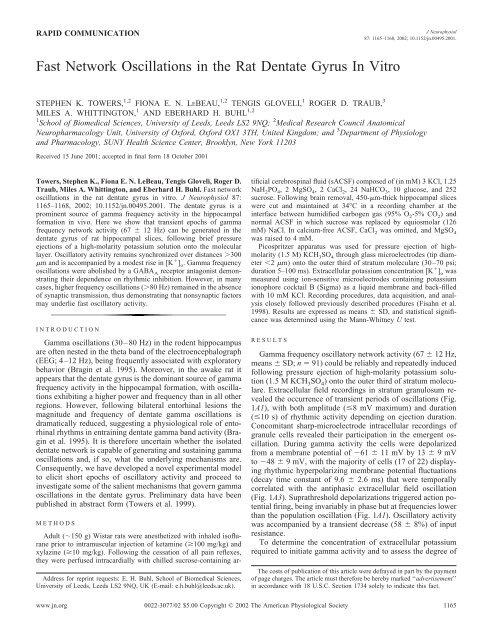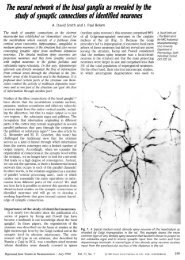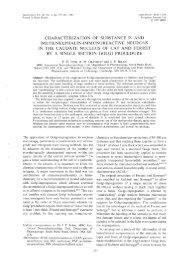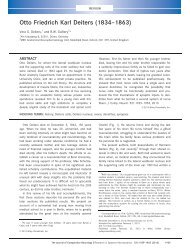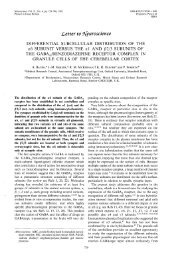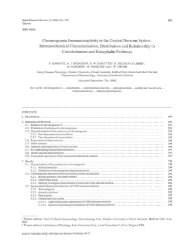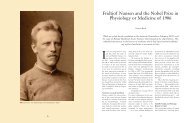Fast Network Oscillations in the Rat Dentate Gyrus In Vitro
Fast Network Oscillations in the Rat Dentate Gyrus In Vitro
Fast Network Oscillations in the Rat Dentate Gyrus In Vitro
Create successful ePaper yourself
Turn your PDF publications into a flip-book with our unique Google optimized e-Paper software.
RAPID COMMUNICATION<br />
J Neurophysiol<br />
87: 1165–1168, 2002; 10.1152/jn.00495.2001.<br />
<strong>Fast</strong> <strong>Network</strong> <strong>Oscillations</strong> <strong>in</strong> <strong>the</strong> <strong>Rat</strong> <strong>Dentate</strong> <strong>Gyrus</strong> <strong>In</strong> <strong>Vitro</strong><br />
STEPHEN K. TOWERS, 1,2 FIONA E. N. LEBEAU, 1,2 TENGIS GLOVELI, 1 ROGER D. TRAUB, 3<br />
MILES A. WHITTINGTON, 1 AND EBERHARD H. BUHL 1,2<br />
1 School of Biomedical Sciences, University of Leeds, Leeds LS2 9NQ; 2 Medical Research Council Anatomical<br />
Neuropharmacology Unit, University of Oxford, Oxford OX1 3TH, United K<strong>in</strong>gdom; and 3 Department of Physiology<br />
and Pharmacology, SUNY Health Science Center, Brooklyn, New York 11203<br />
Received 15 June 2001; accepted <strong>in</strong> f<strong>in</strong>al form 18 October 2001<br />
Towers, Stephen K., Fiona E. N. LeBeau, Tengis Gloveli, Roger D.<br />
Traub, Miles A. Whitt<strong>in</strong>gton, and Eberhard H. Buhl. <strong>Fast</strong> network<br />
oscillations <strong>in</strong> <strong>the</strong> rat dentate gyrus <strong>in</strong> vitro. J Neurophysiol 87:<br />
1165–1168, 2002; 10.1152/jn.00495.2001. The dentate gyrus is a<br />
prom<strong>in</strong>ent source of gamma frequency activity <strong>in</strong> <strong>the</strong> hippocampal<br />
formation <strong>in</strong> vivo. Here we show that transient epochs of gamma<br />
frequency network activity (67 12 Hz) can be generated <strong>in</strong> <strong>the</strong><br />
dentate gyrus of rat hippocampal slices, follow<strong>in</strong>g brief pressure<br />
ejections of a high-molarity potassium solution onto <strong>the</strong> molecular<br />
layer. Oscillatory activity rema<strong>in</strong>s synchronized over distances 300<br />
m and is accompanied by a modest rise <strong>in</strong> [K ] o . Gamma frequency<br />
oscillations were abolished by a GABA A receptor antagonist demonstrat<strong>in</strong>g<br />
<strong>the</strong>ir dependence on rhythmic <strong>in</strong>hibition. However, <strong>in</strong> many<br />
cases, higher frequency oscillations (80 Hz) rema<strong>in</strong>ed <strong>in</strong> <strong>the</strong> absence<br />
of synaptic transmission, thus demonstrat<strong>in</strong>g that nonsynaptic factors<br />
may underlie fast oscillatory activity.<br />
INTRODUCTION<br />
Gamma oscillations (30–80 Hz) <strong>in</strong> <strong>the</strong> rodent hippocampus<br />
are often nested <strong>in</strong> <strong>the</strong> <strong>the</strong>ta band of <strong>the</strong> electroencephalograph<br />
(EEG; 4–12 Hz), be<strong>in</strong>g frequently associated with exploratory<br />
behavior (Brag<strong>in</strong> et al. 1995). Moreover, <strong>in</strong> <strong>the</strong> awake rat it<br />
appears that <strong>the</strong> dentate gyrus is <strong>the</strong> dom<strong>in</strong>ant source of gamma<br />
frequency activity <strong>in</strong> <strong>the</strong> hippocampal formation, with oscillations<br />
exhibit<strong>in</strong>g a higher power and frequency than <strong>in</strong> all o<strong>the</strong>r<br />
regions. However, follow<strong>in</strong>g bilateral entorh<strong>in</strong>al lesions <strong>the</strong><br />
magnitude and frequency of dentate gamma oscillations is<br />
dramatically reduced, suggest<strong>in</strong>g a physiological role of entorh<strong>in</strong>al<br />
rhythms <strong>in</strong> entra<strong>in</strong><strong>in</strong>g dentate gamma band activity (Brag<strong>in</strong><br />
et al. 1995). It is <strong>the</strong>refore uncerta<strong>in</strong> whe<strong>the</strong>r <strong>the</strong> isolated<br />
dentate network is capable of generat<strong>in</strong>g and susta<strong>in</strong><strong>in</strong>g gamma<br />
oscillations and, if so, what <strong>the</strong> underly<strong>in</strong>g mechanisms are.<br />
Consequently, we have developed a novel experimental model<br />
to elicit short epochs of oscillatory activity and proceed to<br />
<strong>in</strong>vestigate some of <strong>the</strong> salient mechanisms that govern gamma<br />
oscillations <strong>in</strong> <strong>the</strong> dentate gyrus. Prelim<strong>in</strong>ary data have been<br />
published <strong>in</strong> abstract form (Towers et al. 1999).<br />
METHODS<br />
Address for repr<strong>in</strong>t requests: E. H. Buhl, School of Biomedical Sciences,<br />
University of Leeds, Leeds LS2 9NQ, UK (E-mail: e.h.buhl@leeds.ac.uk).<br />
Adult (150 g) Wistar rats were anes<strong>the</strong>tized with <strong>in</strong>haled isoflurane<br />
prior to <strong>in</strong>tramuscular <strong>in</strong>jection of ketam<strong>in</strong>e (100 mg/kg) and<br />
xylaz<strong>in</strong>e (10 mg/kg). Follow<strong>in</strong>g <strong>the</strong> cessation of all pa<strong>in</strong> reflexes,<br />
<strong>the</strong>y were perfused <strong>in</strong>tracardially with chilled sucrose-conta<strong>in</strong><strong>in</strong>g artificial<br />
cerebrosp<strong>in</strong>al fluid (sACSF) composed of (<strong>in</strong> mM) 3 KCl, 1.25<br />
NaH 2 PO 4 , 2 MgSO 4 , 2 CaCl 2 , 24 NaHCO 3 , 10 glucose, and 252<br />
sucrose. Follow<strong>in</strong>g bra<strong>in</strong> removal, 450-m-thick hippocampal slices<br />
were cut and ma<strong>in</strong>ta<strong>in</strong>ed at 34°C <strong>in</strong> a record<strong>in</strong>g chamber at <strong>the</strong><br />
<strong>in</strong>terface between humidified carbogen gas (95% O 2 -5% CO 2 ) and<br />
normal ACSF <strong>in</strong> which sucrose was replaced by equiosmolar (126<br />
mM) NaCl. <strong>In</strong> calcium-free ACSF, CaCl 2 was omitted, and MgSO 4<br />
was raised to 4 mM.<br />
Picospritzer apparatus was used for pressure ejection of highmolarity<br />
(1.5 M) KCH 3 SO 4 through glass microelectrodes (tip diameter<br />
2 m) onto <strong>the</strong> outer third of stratum moleculare (30–70 psi;<br />
duration 5–100 ms). Extracellular potassium concentration [K ] o was<br />
measured us<strong>in</strong>g ion-sensitive microelectrodes conta<strong>in</strong><strong>in</strong>g potassium<br />
ionophore cocktail B (Sigma) as a liquid membrane and back-filled<br />
with 10 mM KCl. Record<strong>in</strong>g procedures, data acquisition, and analysis<br />
closely followed previously described procedures (Fisahn et al.<br />
1998). Results are expressed as means SD, and statistical significance<br />
was determ<strong>in</strong>ed us<strong>in</strong>g <strong>the</strong> Mann-Whitney U test.<br />
RESULTS<br />
Gamma frequency oscillatory network activity (67 12 Hz,<br />
means SD; n 91) could be reliably and repeatedly <strong>in</strong>duced<br />
follow<strong>in</strong>g pressure ejection of high-molarity potassium solution<br />
(1.5 M KCH 3 SO 4 ) onto <strong>the</strong> outer third of stratum moleculare.<br />
Extracellular field record<strong>in</strong>gs <strong>in</strong> stratum granulosum revealed<br />
<strong>the</strong> occurrence of transient periods of oscillations (Fig.<br />
1A1), with both amplitude (8 mV maximum) and duration<br />
(10 s) of rhythmic activity depend<strong>in</strong>g on ejection duration.<br />
Concomitant sharp-microelectrode <strong>in</strong>tracellular record<strong>in</strong>gs of<br />
granule cells revealed <strong>the</strong>ir participation <strong>in</strong> <strong>the</strong> emergent oscillation.<br />
Dur<strong>in</strong>g gamma activity <strong>the</strong> cells were depolarized<br />
from a membrane potential of 61 11 mV by 13 9mV<br />
to 48 9 mV, with <strong>the</strong> majority of cells (17 of 22) display<strong>in</strong>g<br />
rhythmic hyperpolariz<strong>in</strong>g membrane potential fluctuations<br />
(decay time constant of 9.6 2.6 ms) that were temporally<br />
correlated with <strong>the</strong> antiphasic extracellular field oscillation<br />
(Fig. 1A3). Suprathreshold depolarizations triggered action potential<br />
fir<strong>in</strong>g, be<strong>in</strong>g <strong>in</strong>variably <strong>in</strong> phase but at frequencies lower<br />
than <strong>the</strong> population oscillation (Fig. 1A1). Oscillatory activity<br />
was accompanied by a transient decrease (58 8%) of <strong>in</strong>put<br />
resistance.<br />
To determ<strong>in</strong>e <strong>the</strong> concentration of extracellular potassium<br />
required to <strong>in</strong>itiate gamma activity and to assess <strong>the</strong> degree of<br />
The costs of publication of this article were defrayed <strong>in</strong> part by <strong>the</strong> payment<br />
of page charges. The article must <strong>the</strong>refore be hereby marked ‘‘advertisement’’<br />
<strong>in</strong> accordance with 18 U.S.C. Section 1734 solely to <strong>in</strong>dicate this fact.<br />
www.jn.org<br />
0022-3077/02 $5.00 Copyright © 2002 The American Physiological Society<br />
1165
1166 TOWERS, LEBEAU, GLOVELI, TRAUB, WHITTINGTON, AND BUHL<br />
FIG. 1. Pressure ejections of high-molarity potassium solution<br />
elicit transient periods of gamma frequency oscillations. A1:<br />
example of extracellular field record<strong>in</strong>g and concomitantly recorded<br />
granule cell follow<strong>in</strong>g <strong>in</strong>duction of oscillatory activity.<br />
At a depolarized membrane potential, rhythmic <strong>in</strong>hibitory<br />
postsynaptic potentials (IPSPs) are apparent, which disappear<br />
near <strong>the</strong> presumed IPSP reversal (72 mV). <strong>In</strong>tracellular record<strong>in</strong>g<br />
shows both rhythmic IPSPs and action potentials.<br />
* Truncated action potential. A2: correspond<strong>in</strong>g power spectra<br />
of oscillatory activity from extracellular and <strong>in</strong>tracellular record<strong>in</strong>gs<br />
reveal a dist<strong>in</strong>ct peak at 55 Hz. A3: cross-correlations of<br />
<strong>in</strong>tracellular and extracellular traces show that granule cell<br />
postsynaptic potentials are phase-related to <strong>the</strong> extracellular<br />
field. B: record<strong>in</strong>gs of extracellular potassium concentration<br />
changes accompany<strong>in</strong>g oscillatory activity. B1: pressure ejection<br />
under control conditions caused [K ] o to rise to 4.1 1.5 mM.<br />
B2: application of tetrodotox<strong>in</strong> (TTX) to block activity-dependent<br />
<strong>in</strong>creases of [K ] o resulted <strong>in</strong> a reduction to 63 22% of<br />
<strong>the</strong> control response.<br />
activity-dependent changes, an ion-sensitive electrode was positioned<br />
at a depth of approximately 100 m <strong>in</strong> close proximity<br />
to <strong>the</strong> field electrode. <strong>Oscillations</strong> of representative amplitude<br />
and duration lead to a modest <strong>in</strong>crease <strong>in</strong> [K ] o of 1.4 1.5<br />
mM (n 9; Fig. 1B1), compris<strong>in</strong>g both exogenously applied<br />
K and activity-dependent <strong>in</strong>creases. To dist<strong>in</strong>guish <strong>the</strong> relative<br />
contribution of both components, successive measurements<br />
were made, both after <strong>the</strong> <strong>in</strong>duction of rhythmic network<br />
activity and follow<strong>in</strong>g <strong>the</strong> bath application of 1 M tetrodotox<strong>in</strong><br />
(TTX), which <strong>in</strong>variably abolished <strong>the</strong> oscillation. After<br />
normaliz<strong>in</strong>g [K ] o levels <strong>in</strong> TTX, <strong>the</strong>se data suggest that action<br />
potential–dependent network activity leads, on average, to a<br />
[K ] o rise of 21 34% (n 5).<br />
An assessment of <strong>the</strong> spatial extent of oscillatory activity<br />
along <strong>the</strong> transverse axis of <strong>the</strong> dentate gyrus was made us<strong>in</strong>g<br />
four extracellular field electrodes that were placed 100 m<br />
apart <strong>in</strong>to <strong>the</strong> granule cell layer (Fig. 2A). Cross-correlations of<br />
population activity at different locations showed that network<br />
activity was tightly synchronized, with phase lags be<strong>in</strong>g 1ms<br />
across distances up to 300 m (Fig. 2B; n 4).<br />
Subsequently, glutamate and GABA receptor pharmacology<br />
was employed to determ<strong>in</strong>e <strong>the</strong> receptor and/or synaptic mechanisms<br />
underly<strong>in</strong>g <strong>the</strong> generation of rhythmic network activity.<br />
<strong>Oscillations</strong> rema<strong>in</strong>ed <strong>in</strong> <strong>the</strong> presence of <strong>the</strong> -am<strong>in</strong>o-3-<br />
hydroxy-5-methyl-4-isoxazolepropionic acid (AMPA)/ka<strong>in</strong>ate<br />
receptor antagonist 6-nitro-7-sulphamoylbenzo(f)-qu<strong>in</strong>oxal<strong>in</strong>e-<br />
2,3-dione (NBQX) (20 M) and <strong>the</strong> N-methyl-D-aspartate<br />
(NMDA) receptor antagonist D-2-am<strong>in</strong>o-5-phosphonopentanoic<br />
acid (D-AP5) (50 M; n 7). The GABA A receptor antagonist<br />
bicucull<strong>in</strong>e (10–20 M; ei<strong>the</strong>r added <strong>in</strong>dividually or follow<strong>in</strong>g<br />
superfusion with NBQX and D-AP5) totally abolished oscillatory<br />
activity <strong>in</strong> 4 of 13 experiments (Fig. 3A). However, <strong>in</strong> <strong>the</strong> majority<br />
of experiments <strong>in</strong> which bicucull<strong>in</strong>e was applied or <strong>in</strong> which <strong>the</strong>re<br />
was conjo<strong>in</strong>t application of antagonists of fast excitatory am<strong>in</strong>o<br />
acid (NBQX, 20 M; D-AP5, 50 M) and GABAergic transmission<br />
(bicucull<strong>in</strong>e, CGP55845, 1–5 M; Fig. 3B), oscillatory network<br />
activity was dim<strong>in</strong>ished <strong>in</strong> peak amplitude but rema<strong>in</strong>ed,<br />
albeit with a higher frequency (17 of 19 experiments; n 19<br />
slices; 86 17 Hz vs. 67 12 Hz <strong>in</strong> control; P 0.0001).<br />
Likewise, oscillations of a significantly higher frequency (97 35<br />
Hz; P 0.0001; n 16) could also be evoked <strong>in</strong> calcium-free<br />
ACSF (Fig. 3C).<br />
J Neurophysiol • VOL 87 • FEBRUARY 2002 • www.jn.org
DENTATE GYRUS OSCILLATIONS<br />
1167<br />
FIG. 2. Oscillatory network activity was tightly synchronized<br />
over distances 300 m. A: population activity recorded<br />
at 4 sites (E1–E4) spaced 100 m from each o<strong>the</strong>r <strong>in</strong> str.<br />
granulosum. B: cross-correlogram of activity recorded at sites<br />
1:4 <strong>in</strong>dicates a phase-lag of 1 ms. C: 1 correspond<strong>in</strong>g power<br />
spectrum is shown.<br />
FIG. 3. Both synaptic and nonsynaptic factors<br />
underlie fast oscillatory activity. A: <strong>in</strong> 4 of 13<br />
experiments, oscillations were abolished by bicucull<strong>in</strong>e.<br />
B: <strong>in</strong> most <strong>in</strong>stances extra- and <strong>in</strong>tracellular<br />
(action potentials truncated) oscillatory activity rema<strong>in</strong>ed,<br />
follow<strong>in</strong>g <strong>the</strong> conjo<strong>in</strong>t application of ionotropic<br />
glutamate and GABA A and GABA B receptors<br />
antagonists, with correspond<strong>in</strong>g power spectra<br />
reveal<strong>in</strong>g dist<strong>in</strong>ct spectral peaks. Cross-correlograms<br />
<strong>in</strong>dicate an anti-phasic relationship between<br />
extra- and <strong>in</strong>tracellular activity. C: oscillatory activity<br />
rema<strong>in</strong>s after superfusion of calcium-free solution.<br />
However, correspond<strong>in</strong>g power spectra reveal<br />
a significant <strong>in</strong>crease <strong>in</strong> peak frequency of<br />
oscillations.<br />
J Neurophysiol • VOL 87 • FEBRUARY 2002 • www.jn.org
1168 TOWERS, LEBEAU, GLOVELI, TRAUB, WHITTINGTON, AND BUHL<br />
DISCUSSION<br />
Here we provide physiological evidence show<strong>in</strong>g that brief<br />
pressure application of a high-molarity potassium solution can<br />
elicit transient gamma-frequency oscillations <strong>in</strong> <strong>the</strong> dentate<br />
gyrus <strong>in</strong> vitro. <strong>In</strong> <strong>the</strong> absence of any phasic <strong>in</strong>put, it is <strong>the</strong>refore<br />
reasonable to assume that <strong>the</strong> generation of rhythmic activity is<br />
an emergent property of <strong>the</strong> neuronal network. We suggest that<br />
<strong>the</strong> focal depolarization of granule cell dendrites <strong>in</strong> <strong>the</strong> outer<br />
molecular layer mimics <strong>the</strong> excitatory <strong>in</strong>put provided by <strong>the</strong><br />
entorh<strong>in</strong>al afferents, which appear to be largely responsible for<br />
<strong>in</strong>duc<strong>in</strong>g, but not necessarily entra<strong>in</strong><strong>in</strong>g dentate oscillatory<br />
activity <strong>in</strong> vivo (Brag<strong>in</strong> et al. 1995). While transient gamma<br />
oscillations are phenomenologically similar to so-called “afterdischarge<br />
term<strong>in</strong>ation oscillations” (ATOs) that may follow<br />
a period of <strong>in</strong>tense perforant path stimulation, <strong>the</strong> latter are<br />
accompanied by slowly propagat<strong>in</strong>g large-amplitude DC shifts<br />
and a dramatic decrease <strong>in</strong> <strong>in</strong>terneuronal activity (Brag<strong>in</strong> et al.<br />
1997). Likewise, potassium-<strong>in</strong>duced spread<strong>in</strong>g depression<br />
(SD) <strong>in</strong> vitro is also accompanied by a cessation of neuronal<br />
activity, a dramatic rise <strong>in</strong> extracellular potassium, and slowly<br />
propagat<strong>in</strong>g DC shifts (Herreras et al. 1994). <strong>In</strong>terest<strong>in</strong>gly,<br />
however, <strong>the</strong> onset of spread<strong>in</strong>g depression may be preceded<br />
by a transient burst of gamma-like activity (Herreras et al.<br />
1994). <strong>In</strong> contrast to SD and ATOs, we are also able to evoke<br />
oscillatory activity without appreciable extracellular DC shifts<br />
(e.g., Fig. 1B). Moreover, dentate <strong>in</strong>terneurons fire vigorously<br />
(Towers, unpublished data), as evidenced by hyperpolariz<strong>in</strong>g<br />
phase-locked <strong>in</strong>hibitory postsynaptic potentials <strong>in</strong> granule cells<br />
and <strong>the</strong> pharmacological antagonism of GABA A receptors,<br />
which ei<strong>the</strong>r resulted <strong>in</strong> a decrease or complete loss of oscillatory<br />
power. F<strong>in</strong>ally, <strong>the</strong> block of GABA A receptors also lead<br />
to a frequency <strong>in</strong>crease of <strong>the</strong> residual oscillation beyond a<br />
range (80 Hz), where <strong>in</strong>hibitory mechanisms are believed to<br />
play a pivotal role <strong>in</strong> phas<strong>in</strong>g oscillatory network activity<br />
(Whitt<strong>in</strong>gton et al. 1995, 1997). It <strong>the</strong>refore appears that dentate<br />
gamma oscillations <strong>in</strong> vitro resemble experimental models<br />
of <strong>in</strong>hibition-based gamma rhythms that depend on tonically<br />
excited networks of mutually <strong>in</strong>terconnected <strong>in</strong>terneurons<br />
(Whitt<strong>in</strong>gton et al. 1995, 1997).<br />
<strong>Dentate</strong> fast rhythms also differ from pharmacological models<br />
of persistent gamma oscillatory activity that require <strong>the</strong><br />
presence of AMPA/ka<strong>in</strong>ate receptors (Fisahn et al. 1998),<br />
whereas high [K ] o -<strong>in</strong>duced gamma activity rema<strong>in</strong>ed <strong>in</strong> <strong>the</strong><br />
absence of fast glutamatergic excitation. It <strong>the</strong>refore appears<br />
that <strong>the</strong> synaptic mechanisms that sculpt dentate gamma activity<br />
resemble those of <strong>in</strong>hibition-based gamma rhythms that<br />
depend on tonically excited networks of mutually <strong>in</strong>terconnected<br />
<strong>in</strong>terneurons (Whitt<strong>in</strong>gton et al. 1995, 1997).<br />
Despite <strong>the</strong> important role of <strong>in</strong>hibitory mechanisms <strong>in</strong> govern<strong>in</strong>g<br />
oscillatory network activity <strong>in</strong> <strong>the</strong> gamma frequency<br />
range, <strong>the</strong> dentate neuronal network can generate high-frequency<br />
oscillatory activity that appears to be entirely dependent<br />
on nonsynaptic factors, not unlike dentate ATOs (Brag<strong>in</strong><br />
et al. 1997). Regard<strong>in</strong>g <strong>the</strong> underly<strong>in</strong>g mechanisms, <strong>the</strong> low<br />
extracellular volume fraction of <strong>the</strong> dentate gyrus and common<br />
orientation of granule cells do <strong>in</strong>deed favor a contribution of<br />
electrical field effects (Snow and Dudek 1986). Likewise,<br />
experimental conditions may also facilitate synchroniz<strong>in</strong>g field<br />
effects dur<strong>in</strong>g tetanically evoked oscillatory activity <strong>in</strong> <strong>the</strong> CA1<br />
area (Bracci et al. 1999; Whitt<strong>in</strong>gton et al. 2001). However, <strong>the</strong><br />
overt absence of a significant degree of a net transmembrane<br />
depolarization, sporadic fir<strong>in</strong>g of granule cells, and a relatively<br />
modest drop <strong>in</strong> neuronal <strong>in</strong>put resistance are more likely to<br />
favor a prom<strong>in</strong>ent contribution of o<strong>the</strong>r synchroniz<strong>in</strong>g factors,<br />
such as gap junction–mediated electrical neuronal coupl<strong>in</strong>g<br />
(Draguhn et al. 1998; Kosaka 1983; Venance et al. 2000). <strong>In</strong><br />
summary, we <strong>the</strong>refore suggest that oscillatory activity <strong>in</strong> <strong>the</strong><br />
dentate gyrus is due to a complex <strong>in</strong>terplay of synaptic and<br />
nonsynaptic network mechanisms.<br />
We thank Prof. Peter Somogyi for support dur<strong>in</strong>g <strong>the</strong> <strong>in</strong>itiation of this<br />
project, Drs. Andrea Bibbig and Andreas Draguhn for stimulat<strong>in</strong>g discussions,<br />
and D. Harrison for excellent technical support.<br />
This work was supported by <strong>the</strong> British Medical Research Council and <strong>the</strong><br />
Wellcome Trust.<br />
REFERENCES<br />
BRACCI E, VREUGDENHIL M, HACK SP, AND JEFFERYS JGR. On <strong>the</strong> synchroniz<strong>in</strong>g<br />
mechanisms of tetanically <strong>in</strong>duced hippocampal oscillations. J Neurosci<br />
19: 8104–8113, 1999.<br />
BRAGIN A, JANDO G, NADASDY Z, HETKE J, WISE K, AND BUZSAKI G. Gamma<br />
(40–100 Hz) oscillation <strong>in</strong> <strong>the</strong> hippocampus of <strong>the</strong> behav<strong>in</strong>g rat. J Neurosci<br />
15: 47–60, 1995.<br />
BRAGIN A, PENTTONEN M, AND BUZSAKI G. Term<strong>in</strong>ation of epileptic afterdischarge<br />
<strong>in</strong> <strong>the</strong> hippocampus. J Neurosci 17: 2567–2579, 1997.<br />
DRAGUHN A, TRAUB RD, SCHMITZ D, AND JEFFERYS JGR. Electrical coupl<strong>in</strong>g<br />
underlies high-frequency oscillations <strong>in</strong> <strong>the</strong> hippocampus <strong>in</strong> vitro. Nature<br />
394: 189–192, 1998.<br />
FISAHN A, PIKE FG, BUHL EH, AND PAULSEN O. Chol<strong>in</strong>ergic <strong>in</strong>duction of<br />
network oscillations at 40 Hz <strong>in</strong> <strong>the</strong> hippocampus <strong>in</strong> vitro. Nature 394:<br />
186–189, 1998.<br />
HERRERAS O, LARGO C, IBARZ JM, SOMJEN GG, AND MARTIN DEL RIO R. Role<br />
of neuronal synchroniz<strong>in</strong>g mechanisms <strong>in</strong> <strong>the</strong> propagation of spread<strong>in</strong>g<br />
depression <strong>in</strong> <strong>the</strong> <strong>in</strong> vivo hippocampus. J Neurosci 14: 7087–7098, 1994.<br />
KOSAKA T. Neuronal gap junctions <strong>in</strong> <strong>the</strong> polymorph layer of <strong>the</strong> rat dentate<br />
gyrus. Bra<strong>in</strong> Res 277: 347–351, 1983.<br />
SNOW RW AND DUDEK FE. Evidence for neuronal <strong>in</strong>teractions by electrical<br />
field effects <strong>in</strong> <strong>the</strong> CA3 and dentate regions or rat hippocampal slices. Bra<strong>in</strong><br />
Res 367: 292–295, 1986.<br />
TOWERS SK, LEBEAU FEN, AND BUHL EH. Synaptic and non-synaptic mechanisms<br />
of oscillatory network activity <strong>in</strong> <strong>the</strong> rat dentate gyrus <strong>in</strong> vitro<br />
(Abstract). J Physiol (Lond) 523: P186, 1999.<br />
VENANCE L, ROZOV A, BLATOW M, BURNASHEV N, FELDMEYER D, AND<br />
MONYER H. Connex<strong>in</strong> expression <strong>in</strong> electrically coupled postnatal rat bra<strong>in</strong><br />
neurons. Proc Natl Acad Sci USA 97: 10260–10265, 2000.<br />
WHITTINGTON MA, DOHENY HC, TRAUB RD, LEBEAU FEN, AND BUHL EH.<br />
Differential expression of synaptic and nonsynaptic mechanisms underly<strong>in</strong>g<br />
stimulus-<strong>in</strong>duced gamma oscillations <strong>in</strong> vitro. J Neurosci 21: 1727–1738,<br />
2001.<br />
WHITTINGTON MA, STANFORD IM, COLLING SB, JEFFERYS JGR, AND TRAUB<br />
RD. Spatiotemporal patterns of gamma frequency oscillations tetanically<br />
<strong>in</strong>duced <strong>in</strong> <strong>the</strong> rat hippocampal slice. J Physiol (Lond) 502: 591–607, 1997.<br />
WHITTINGTON MA, TRAUB RD, AND JEFFERYS JGR. Synchronised oscillations<br />
<strong>in</strong> <strong>in</strong>terneuron networks driven by metabotropic glutamate receptor activation.<br />
Nature 373: 612–615, 1995.<br />
J Neurophysiol • VOL 87 • FEBRUARY 2002 • www.jn.org


